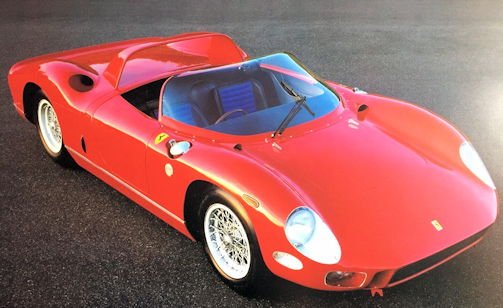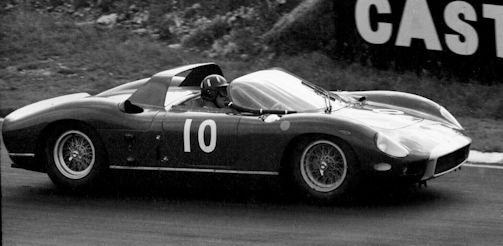Ferrari 330P
 | |
Builder | Ferrari |
Class | Race Car |
Category | World sports prototype championship |
Chassis | Trillis made of steel tubes |
Motor | V12 from 3967.44 cm³ |
Transmission | 5-speed gearbox, rear-wheel drive |
Wheelbase | 2400 mm |
Weight | 785 kg |
The Ferrari 330P was a racing sports car that the Scuderia Ferrari developed in 1963 for sports car racing who participated in the World Sports Prototype Championship.
History
For 1964 Ferrari decided not to design a new car, and instead tried to increase the performance of the 250 P. The first evolution , the 275 P, saw the increase in the bore from 73mm to 77mm, bringing the displacement to 3285.72 cm³. The compression ratio was increased to 9.7:1. The power output was 320 HP at 7700rpm. The weight dropped to 755 kg. Six 275 Ps were built, of these three were modified 250 Ps, those with chassis numbers 0812, 0814 and 0816. Another three were built from scratch, with chassis numbers 0818, 0820 and 0822. In the same year Ferrari decided to further increase the performance of these cars. On the 330 P, as they were renamed, the displacement grew to 3967.44 cm³ following the increase in the stroke to 71mm. The compression ratio was further raised to 9.8:1. Power reached 370 hp. The cars that underwent these modifications were the 250 P chassis number 0810 and the 275 P chassis numbers 0814, 0818, 0820 and 0822. A sixth 330 P was also built, with chassis number 0824 Both the 275 P and the 330 P had the wheelbase extended to 2500mm.
The first Ferrari racing model of the 330P series was an adapted Ferrari 250P . The difference was in the engine. While in the 250P a 3-liter V12 engine provided power, the 330P was fitted with the 3.9-liter 12-cylinder engine. As in the 330LMB and 330TRI , the engine block was taken from the Ferrari 400 Superamerica and adapted for racing. The cylinder heads, pistons, valve drive and dry sump lubrication were adopted from the 250 Testa Rossa . The performance data varies according to the source and should have been in the range between 370 and 390 hp. In 1964, the 330P was the equivalent of the 275P . Chassis and bodies completely agreed. The only distinguishing feature was the engine; in the 275P he had 3.3-liter displacement in the 330P 3.9-liter, made with 390 hp 20 hp more, but also made the car by 30 kg heavier than the 275P model.
Ferrari gave the chassis 0810, 0818, 0820 and 0822 as an adaptation of the 275P, the chassis 0814 as a counterpart to the 250P.
The 275 P and 330 P debuted on March 21 at the 12 Hours of Sebring. The two 275 Ps in the race took the first two places, respectively with the crews Parkes/Maglioli and Scarfiotti/Vaccarella. Third place went to a 330 P, with Surtees and Bandini driving . A second 330 P, crewed by Hill/Bonnier, was forced to withdrawal due to the breakage of the gearbox. The only 330 P in the race took the victory Goodwood circuit, which took place on the RAC Tourist Trophy. On 29 May, at the head gasket and Nino Vaccarella at the wheel. The podium was completed by two 330 Ps, brought to the race by the Hill/Bonnier and Surtees/Bandini crews. The third 330 P withdrew due to the failure of the Jean Guichet. The third managed to get to first place, with oil pump, which took place on 22 June, Ferrari fielded three 275 Ps and three 330 Ps. Of the 275 Ps, two retired , respectively due to an accident and the breakdown of the 24 Hours of Le Mans. In July 1963 at the Grand Prix of Silverstone . The car was reported by the British racing team Maranello Concessionaires , driven by Mike Parkes . The checkered flag did not see the Briton after the fastest training time because of engine damage. The race was won by Roy Salvadori on a Cooper T61 Monaco .
At Le Mans , the 330P came second (Maranello Concessionaires driven by Hill / Bonnier) and three (works cars driven by Surtees / Bandini). The overall victory went to Jean Guichet and Nino Vaccarella in the factory-275P. The first victory with the race car type celebrated Graham Hill in August 1964 during the counting for the World Cup RAC Tourist Trophy .330P were driven until 1967 in sports car racing, the factory team 1965 replaced by the P2 .
Comparison between the evolutions
Model | Displacement | Unit displacement | Power | Bore x stroke | Compression ratio |
250 P | 2953.21 cm³ | 246.1 cm³ | 310 CV @ 7500 rpm | 73 x 58.8 mm | 9.5:1 |
275 P | 3285.72 cm³ | 273.8 cm³ | 320 hp @ 7700 rpm | 77 x 58.8 mm | 9.7:1 |
330 P | 3967.44 cm³ | 330.6 cm³ | 370 hp @ 7300 rpm | 77 x 71 mm | 9.8:1 |

Rating
Technical
-
Ferrari 330 P Technical details and specifications (1963-1964)
ENGINE:
Four-stroke 12-cylinder V engine
mid-engine
cooling Water with thermostat
capacity 3967 cc
Bore × stroke 77 × 71 mm
compression 8,8: 1
carburettor 6 Weber double carburettors
power 370 hp (272 kW) at 7200 rpm
top speed over 300 km / hTRANSMISSION DRIVE LINE:
Multi-disc dry clutch
5-speed gearbox
rear-wheel driveCHASSIS:
Tubular steel frameSUSPENSION:
front and rear
Handlebar trapeze, coil springs, 1 each stabilizer, telescopic shock absorbersBRAKES:
hydraulically operated disc brakes
DIMENSIONS AND WEIGHT:
Track front / rear 1422/1414 mm
wheelbase 2400 mm
Length × width × height 4160 × 1670 × 1055 mm
Curb weight (without driver) 785 kgWHEELS TYRES:
Tire size front / rear 6.00-15 / 7.00-15



